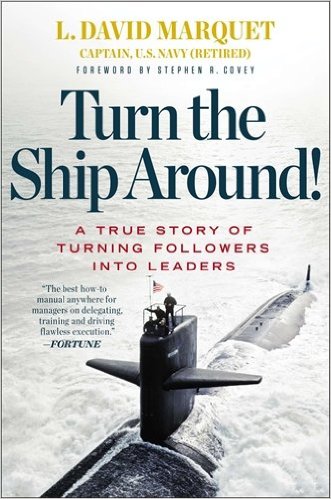Book Review: Turn the Ship Around!
This book is one of the best tactical manuals on empowering leaders I’ve read. A remarkable aspect is how freely David Marquet references other books and blogs for great ideas. Here’s someone who has thought about good leadership for a long time, tried and failed with the old models, and through experimentation in life-and-death situations come up with an answer that produced immediate and lasting results.
What follows are my favorite excerpts and quotes.

“Our greatest struggle is within ourselves. Whatever sense we have of thinking we know something is a barrier to continued learning.”
“To be a leader in service of others, to create other leaders, you need to give control.”
“Are you asking questions to make sure you know or to make sure they know?”
Leader-Follower: a wrong model for leadership
“The problem for Santa Fe wasn’t an absence of leadership. It was too much leadership of the wrong kind, the leader-follower kind.”
Signs of Leader-Follower mentality:
- Everyone was waiting for someone else
- Everyone below the captain and the department heads had their brain shut off
- Each time, someone up the chain of command hadn’t supported the initiative, so nothing happened
- Avoiding mistakes became the primary driver for all actions. They focused exclusively on satisfying the minimum requirements. Anything beyond that was ignored.
- “I’m getting told to do stuff before I even know I have stuff to do!”
- “Not only are they telling me to do stuff I already know I have to do, but also frequently I get told exactly how and when to do it. That takes away any decision-making opportunities I might have.”
- “Hi, what do you do on board?” I asked. “Whatever they tell me to do,” he immediately replied with unmistakable cynicism.
- Each CO is encouraged to maximize performance for his tour and his tour alone.
Leader-Leader: a better model
Is there scope for improvement?
“There was a thirst to do better. There would be an eagerness to change the way we were doing business that I could tap into.”
Are you willing to put yourself as a leader at risk?
“Would I be willing to be vulnerable to the effects of their decisions? On a submarine, a warship, there were lives at stake after all, not just our careers. I would retain accountability for Santa Fe’s operational performance but release control of the actual decisions to the department heads.”
The 3 ingredients of Leader-Leader:
- Give control
- Increase competence (control without competence is chaos)
- Improve organizational clarity
Mechanisms for Giving Control:
- “Achieve Excellence, Don’t Just Avoid Errors”
- “Find the Genetic Code for Control and Rewrite It”
- “Don’t move information to authority, move authority to the information.”
- “Act Your Way to New Thinking”
- “Short, Early Conversations Make Efficient Work”
- “Use “I Intend to . . .” to Turn Passive Followers into Active Leaders”
- “Resist the Urge to Provide Solutions”
- “Eliminate Top-Down Monitoring Systems”
- “Think Out Loud“
- “Embrace the Inspectors“
Mechanisms for Increasing Competence:
- “Take Deliberate Action“
- “We Learn (Everywhere, All the Time)”
- “Don’t Brief, Certify“
- “Continually and Consistently Repeat the Message”
- “Specify Goals, Not Methods”
Mechanisms for Improving Organizational Clarity:
- “Build Trust and Take Care of Your People”
- “Use Your Legacy for Inspiration”
- “Use Guiding Principles for Decision Criteria”
- “Use Immediate Recognition to Reinforce Desired Behaviors”
- “Begin with the End in Mind”
- “Encourage a Questioning Attitude over Blind Obedience”
- “Don’t Empower, Emancipate“
Note: this is part of my 2016 reading list. Check out the complete list here.
